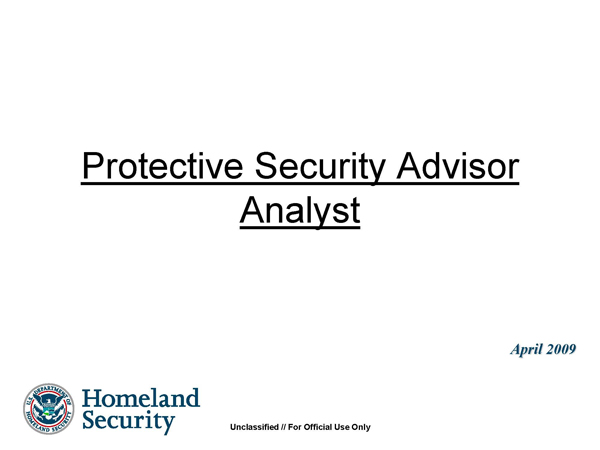Protective Security Analyst Brief
- 9 pages
- For Official Use Only
- April 2009
Mission
• Office of Infrastructure Protection (IP):Lead the coordinated national effort to reduce the risk to our critical infrastructures and key resources (CIKR) posed by acts of terrorism, and strengthen national preparedness, timely response, and rapid recovery in the event of an attack, natural disaster, or other emergency.
• Protective Security Coordination Division (PSCD):Reduce the risk of the Nation’s CIKR of a terrorist attack by assessing vulnerabilities and consequences, and developing, implementing and providing national coordination for protective programs and facilitating CIKR response and recovery operations in an all-hazards environment.
Protective Security Advisor Analyst Focus
The focus of the Protective Security Advisor Analyst (PSAA) is to support the mission of State and Urban Area Fusion Centers by enhancing the protection of critical infrastructure through the analysis of risks to regional CIKR, and by aiding Federal, State, local, and private sector partners with the prioritization of critical infrastructure protection efforts in an all hazards environment.
Value Proposition
PSAAs:
• Serve as an additional capability within Fusion Centers that focuses on securing the Nation’s CIKR –an essential function as Fusion Centers grow and begin to interact with the Private Sector;
• Support and assist Fusion Centers in the coordination, gathering, analysis, and dissemination of primarily homeland security information (e.g. consequence and vulnerability information) as it pertains to critical infrastructure protection; and
• Serve as an important resource to exchange information between the Private Sector, the Fusion Center and both Federal and State/local government. Specifically, PSAAs will be able to communicate with CIKR owners/operators from a regional platform with the latest and most relative information.
…
Fusion Center Guidelines Value Proposition Continued
• In August 2005, the Department of Justice (DOJ) released the Fusion Center Guidelines.
• The Guidelines provide high level direction to State/locals on how to stand up a Fusion Center.
• Interaction with the Private Sector is identified as a key component to the success of a Fusion Center.
• The Guidelines point out several challenges arise when trying to incorporate Private Sector into the day to day operations of Fusion Centers, all of which can be solved by utilizing a PSAA. These include:
– Potential for unauthorized release of information
– Lack of control of data
– Possibility of competitive advantage
– Possibility of proprietary disclosure
– Human resource issues…
Baseline CapabilitiesValue Proposition Continued
• In late 2008, the Baseline Capabilities for State and Urban Area Fusion Centers document was released.
• An appendix to that document is: Critical Infrastructure and Key Resource Protection Capabilities for Fusion Centers.
• This appendix identifies the capabilities necessary for SLFCs to establish a CKR protection analytic capability that supports infrastructure security activities at the State and local level.
• The PSAA’s roles/responsibilities will map to the criteria outlined in the Appendix as needed, thus providing the SLFC with the required level of capability.…
Potential PSAA Primary Responsibilities
• Coordinate and assist in the production of tactical level products by providing national to local level CIKR information to aide not only in the protection of CIKR, but to the combined missions of Federal, State and local partners within each Center as needed. This coordination, integration and knowledge will assist in driving protective programs at both the local and national level;
• Support a comprehensive understanding of the local CIKR vulnerabilities, the potential consequences of attacks, and the effects of risk mitigation actions;
• Work in partnership with PSAs and private sector security in order to obtain and share current and accurate infrastructure information;
• Serve as a liaison, if needed, to CIKR owners and operators, helping to ensure they are incorporated into SLFCs via appropriate information sharing channels;
• Bring more CIP subject matter expertise to SLFCs;
• Provide information on, and assistance with, IP services such as the Constellation/Automated Critical Asset Management System (C/ACAMS) and the Integrated Common Analytical Viewer (iCAV) as requested;Potential PSAA Primary Responsibilities
• Access and integrate CIKR databases such as C/ACAMS to support the prevention and protection efforts of infrastructure of concern at the local and regional level;
• Serve as a conduit between the SLFCs and Infrastructure Information Collection Division (IICD), providing requirements back to the IICD Infrastructure Data Management Branch (IDMB) for infrastructure data collection requirements and the Geospatial Program Office (GPO) for enhancements to the suite of viewer technologies, “push button” geo-processing analytic capability, and real time information feed needs;
• Assist in the prioritization of protection efforts based upon vulnerabilities to CIKR identified during assessments, existing interdependencies between CIKR, and potential cascading effects associated with infrastructure loss or disruption;
• Serve as a conduit for CIKR consequence, vulnerability and interdependency information provided by field-deployed PSAs and apply that knowledge to associated law enforcement and/or threat information received by SLFCs;
• Provide reach-back to IP for subject matter expertise; and
• Fulfill the requirements set forth in Baseline Capabilities for State and Major Urban Area Fusion Centers, Appendix F -CIKR Protection Capabilities for Fusion Centers.

